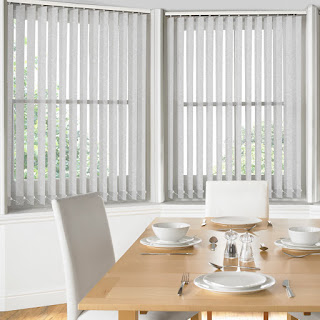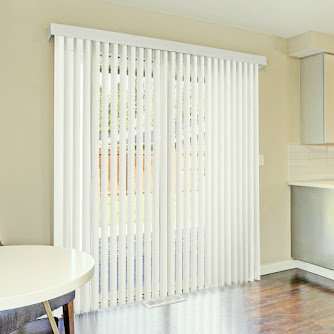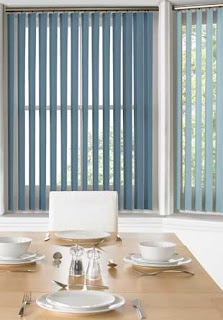Vertical blinds are vertical lengths of fabric
that are clipped to a sliding track at the top and operated with a plastic wand
or chain. These pieces of fabric (also known as louvres or slats) are joined
together by weights to ensure the louvres are evenly weighted across the length
of the track, no matter if they’re fully extended across the track or nestled
together to let extra light inside. The louvres are also joined together by a
chain at the bottom which works to stabilize the blinds.
While the construction of these blinds
seems straightforward, they’re designed to allow ultimate control over privacy
and light in any environment. The vertical louvres tilt and turn depending on
how much of a gap the user wants, plus they can also be drawn back completely
to enable more light into a room. That makes them a great option for any space
where control is paramount but where good design is also crucial.
What Type of Windows Best Suit
Vertical Blinds?
Larger windows that may not
suit horizontal or roller blinds are
ideal locations for vertical blinds. Thanks to their construction of louvres
weighted together, they can be adjusted for windows of any length. If you’re
fitting blinds to a patio window or a long window inside an office, for
example, vertical blinds offer a level of light flexibility that other styles
simply can’t match.
If you have a challenging
window space that is sloped or has a split drop, vertical blinds are also an
effective solution. While you might struggle to install horizontal blinds
across a pitched space, individual vertical louvres can be tailored to your
space, meaning that different blind lengths can be used and the window can be
fully covered.
Any space that would benefit
from floor to ceiling blinds such as a conservatory or a summerhouse are also
prime locations for made to measure vertical blinds.
Benefits of Vertical Blinds
Privacy and control are two of the key
benefits of choosing vertical blinds for your windows instead of the other
popular options on the market.
Vertical blinds allow you to
control the amount of visibility into space without sacrificing light entry.
So, for someone who wanted to ensure that their conservatory received plenty of
natural light without having to worry about everyone being able to see inside,
vertical blinds are an excellent idea. The tilt and turn mechanism can be
manipulated to allow the slats in the blinds to be opened at varying degrees to
suit the users.
Similarly, the amount of light that enters a space through vertical blinds is often superior to the
amount of light that makes it through horizontal blinds, especially those in
thin spaces. Vertical blinds can therefore be a way of admitting more light through
a small window without sacrificing any privacy.
Another important benefit of
vertical blinds are that don’t have to be boring – there are plenty of
designs to choose from that will fit any color scheme and any style.
How to Clean Vertical Blinds
One concern that householders
often have when they’re thinking about vertical blinds for their home or office
is how much effort they’ll take to clean. The truth is, they require
comparatively little maintenance to keep them looking good.
Generally, the louvres on
vertical blinds can be cleaned with just a damp cloth. That will get rid of
most dirt and dust that might attach to them. It’s also a major difference
between vertical and horizontal blinds – while horizontal blinds trap debris
between their slats, the louvres of vertical blinds allow the debris to fall
instead. So, if you’re looking for one fundamental reason to choose vertical
blinds over horizontal ones, the ease of maintenance might be it.
Cleaning the rail that the
blinds hang from can be time-consuming, but this is an occasional task and so
won’t need to be undertaken too frequently. To clean the rail, unclip each of
the blinds and wipe the rail with a damp cloth. If you want to ensure that the
blind mechanism continues to work unimpeded, you can spray a small amount of
silicone spray into the side rail – just be careful not to stain the fabric of
your louvres when you rehang them.
For more stubborn stains,
fabric stain removers can be used in line with the manufacturer’s instructions.
Be aware, though, that you run the risk of the treated area looking slightly
different to the rest of the fabric by using this method.



The article written is really great and informative. will be looking further for these type of posts.
ReplyDeleteOffice blinds and curtains